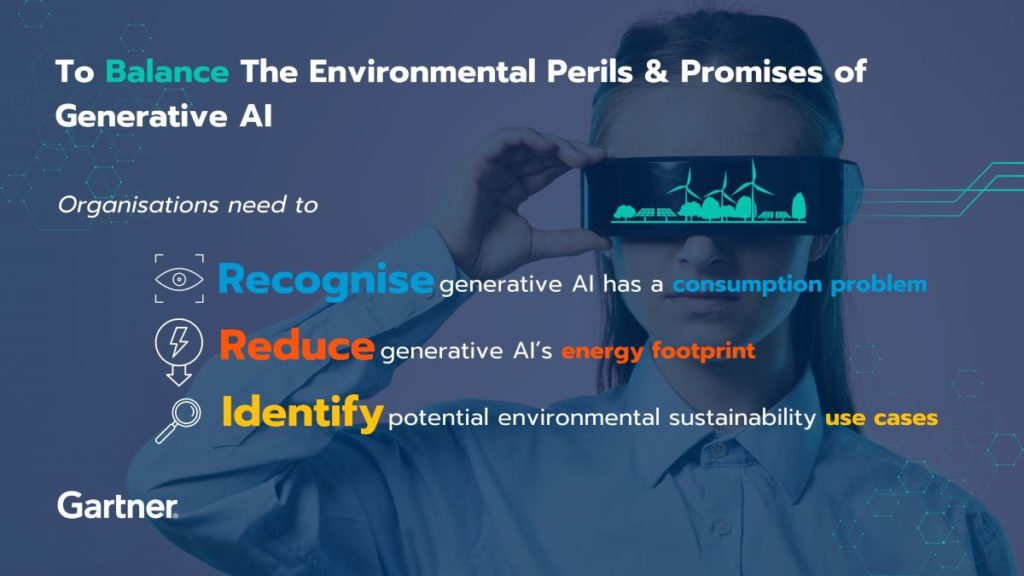By Kristin Moyer, distinguished VP analyst at Gartner
The rapid adoption of ChatGPT has elevated the negative environmental impacts of generative AI from a hyped new technology to an immediate concern for organisations. Plenty of seemingly good use cases powered by this emerging technology will do more harm than good in terms of greenhouse gas (GHG) emissions and electricity and water consumption.
Despite this, generative AI can also accelerate positive sustainability and financial outcomes. If used in the right way and with human oversight, the technology can potentially help companies mitigate sustainability risk, optimise costs and drive growth.
To balance the perils and promises of this technology, organisations need to do two things. First is to recognise and reduce generative AI’s energy footprint to make it more environmentally friendly, then to identify, evaluate and prioritise its environmental sustainability use cases.
Recognise generative AI has a consumption problem
Generative AI relies on huge models trained with massive amounts of data, making it thirsty for cooling water and hungry for electricity. In some cases, the technology can consume vast quantities of both. While electricity-related GHG emissions will decline in the long term as greater renewable energy sources are used, more powerful generative AI models will need increased computing capabilities.
The problem of technology-related electricity and water consumption goes well beyond generative AI. Gartner predicts that 75% of executives will experience technology-related electricity constraints by 2025. As the needs of technology and society compete more intensely with each other, CIOs don’t want to be caught in the position of vying with local communities for finite resources.
Reduce generative AI’s energy footprint
To make generative AI more environmentally friendly, it needs to be as efficient as the human brain. One of the reasons the brain is so energy efficient is that it organises knowledge in network structures. The closest current equivalent to this is composite AI, which uses similar network structures and techniques to complement the current brute force, deep learning method.
Generative AI also needs to be put on an electricity and water diet. Stop training AI as soon as improvements flatten out. Keep data for model training local, reuse models that have already been trained and use more energy-efficient hardware and networking equipment. Balance “follow the sun” data centre workloads that are better for clean energy production, with “unfollow the sun” measures that are better for water efficiency.
Another way to make generative AI more environmentally friendly is to run it in the right place, at the right time. The carbon intensity of the local energy supply varies by a range of factors. Best practice is to use energy-aware job scheduling, along with carbon tracking and forecasting services to reduce related emissions.
Also aim to buy new clean power where you plan to consume it. The Greenhouse Gas Protocol is considering requiring companies to provide more detailed analysis of clean power by location, time of day or both.
Identify potential environmental sustainability use cases
There are three broad areas where generative AI use cases can accelerate environmental sustainability: mitigating risks, optimising costs or driving growth.
Regulatory compliance is one way generative AI can help your organisation in mitigating environmental risk by identifying and interpreting relevant sustainability laws, standards, directives and reporting requirements, including updates over time. It can develop an action plan to achieve compliance and training materials to educate employees on specific regulations.
From a cost optimisation perspective, generative AI can help support decision making. It can analyse internal sustainability data and identify patterns, trends, areas for improvement, feasibility, risks and benchmarks. It can provide insight into how organisational decisions will impact sustainability and forecast likely future performance. Enterprises can therefore plan and select optimal pathways to reach GHG emissions reduction goals.
Generative AI can also be used to drive sustainable growth by applying it to discover alternative resources and materials. It can provide suggestions for sustainable substitutes for conventional inputs; insights on technological innovation such as nanomaterials; and information on availability, performance and environmental impact.
When you are weighing up generative AI use cases for sustainability, it’s important to evaluate the positive and negative impacts. Look at the positive business value in terms of financial and sustainability benefits, as well as feasibility, and the negative environmental impact as measured by GHG emissions, and electricity and water consumption.
You can then prioritise your investments based on three levels: invest now; reduce risk and energy use first; or do not invest. That way, you will be using generative AI to accelerate your organisation’s positive sustainability outcomes by only leveraging those use cases that create more value than they destroy.

